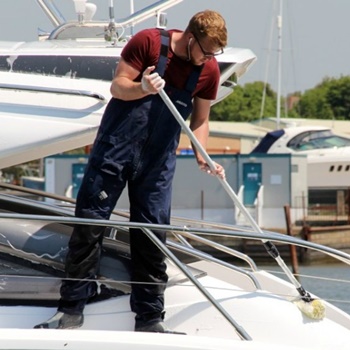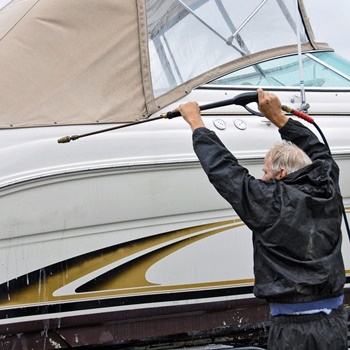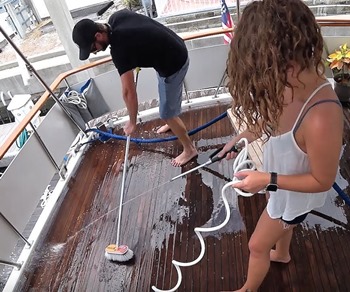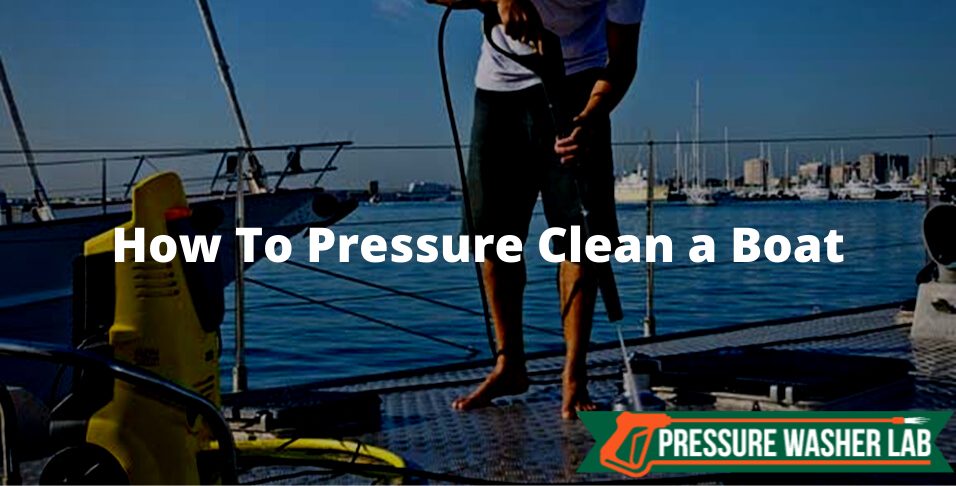Here’s five simple steps to pressure wash a boat:
- Step1: Get all the cleaning tools.
- Step 2: Give the boat a good rinse using a pressure washer.
- Step 3: Clean the boat with detergent.
- Step 4: Rinse off the dirt and detergent after 10-15 minutes
- Step 5: After a final rinse, let your boat dry before applying wax.
The steps to pressure wash boats, special precautions, and post-cleaning routine will be discussed in detail below.
Preparations to Do Before Pressure Washing a Boat

Get a detergent, scrub brush, pressure nozzle, and the user manual that came with the pressure washer ready first. Make sure to be careful with the footing as pressure washing can easily make the user lose grip and injure themselves – it’s wise to wear protective gear for feet, hands, and eyes as well.
The right pressure washer for washing a boat is a medium-duty one with a 2,000 PSI level.
The next step is to remove all loose equipment and objects lying around the boat – anything that may get damaged by the high-pressure water like, seat cushions, walkie-talkies, buckets, life vests, fishing poles, or canopies. This gives the user plenty of room to work with.
If the boat’s hull has an old gel coat, it’s best not to pressure wash that part. Check this by looking for minor chipping and air bubbles on the surface. Pressure washing these could lead to increased damage to the bottom of the boat. Instead, schedule a professional to apply a new gel coat on the boat.
1. Prepare the Boat
Close all the entryways to the interior of the boat. High-pressure water can get into the interiors from tiny openings or windows.
2. Prepare the Pressure Washer Nozzles
Get an angled nozzle with a wide tip. Do not use a zero-degree nozzle as it creates a very concentrated stream of high-pressure water. Pressure from zero-degree nozzles can cause damage to the surface, doors, and windows of the boat.
Pressure washer nozzles are universally color-coded. Pressure washing a boat requires only two nozzle types – the green and black nozzle.
The black nozzle is also known as a ‘soaker nozzle’. It is ideal for detergent application. It has a wide 65-degree spray pattern that discharges low-pressure water to cover larger surface areas with the detergent. Don’t use a higher water pressure because it will simply wash off the detergent without rinsing or cleaning the dirt.
The green nozzle has a 25-degree spray pattern. It has a smaller opening that increases the concentration of water pressure. The green nozzle is ideal to remove tough spots and stains, after applying detergent.
Never hold a pressure nozzle too close to a boat’s surface. The minimum distance between the nozzle and boat surface is 6 to 8-inches.
Choose the right type of pressure nozzle and prevent any unwanted accidents when pressure washing a boat.
3. Pick the Right Pressure Washer Detergent
Check the user manual that came with the pressure washer. Look for approved marine-safe detergents to wash the boat. A good detergent to pressure wash a boat is a biodegradable one with no ammonia bases. Ammonia-based detergents dry out materials like plastic and rubber. They also degrade wax on the boat’s surface, and over time, weaken the frame’s grip on the boat’s glass fittings.
Ask boat shop owners for suggestions on safe and effective pressure washer detergent for the boat. Narrow down the detergent list to a few quality pressure washer detergents, take note of the different prices at available stores, and buy the cheapest one.
Also, get a chemical injection kit. A chemical injection kit will help use the pressure washer with a detergent. The pressure washers on rent already have a chemical injection kit installed. Personal pressure washers need to have a kit installed. The best place to learn how to install a chemical injection kit is from the pressure washer hiring company itself.
4. Keep a Pressure Washer Scrub Brush Available
Get some scrub brush attachments for the pressure washer to clean algae or layers of mildew from the boat.
A pressure washer scrub brush is an attachment head that can be fixed to the pressure washer. It replaces the nozzle head on the pressure washer. The water pressure helps the brush spin and scrub away the dirt. If that doesn’t work, try repeating the same process with some detergent.
Scrub brushes are preferred because they are gentle on the boat. The scrub brush is safe to use on windshields and windows of the boat. Scrub brushes cover more area and are more effective at removing stubborn dirt.
Buy an extender with the scrub head as well. An extender will give further mobility to the pressure washing process of a boat. It can clear out hard-to-reach, narrow spaces and push the scrub head’s reach a little farther – saving you the trouble of clambering around the boat.
Using a scrub brush isn’t mandatory for cleaning the boat, but it’s certainly useful. Choosing the right brush is just as important as choosing the right nozzle. The right scrub brush can help save time and decrease the effort required from the user. Make sure to pick the right scrub brush for your boat.
5. Get a Boat Wax
Give your boat a wax, post-cleaning.
Boat wax is also known as marine or hull wax. Boat wax is a special wax approved for marine use. Marine wax helps protect the boat’s surfaces from damage due to the sun and water.
Get the boat waxed at least once a year. Put a marine safe wax on the boat’s surface including the seats, and watch it significantly extend the durability of the boat materials.
A precaution to remember is to put marine wax on the boat only when it has fully dried. This will be further discussed…
Similar to the scrub brush, a boat wax isn’t a mandatory process. Most boat owners wax their boat once a year while washing their boats. Since they’ll have to wash their boats before waxing them anyway. If it isn’t a hassle, cleaning and waxing the boat all in one go is recommended.
How to Pressure Clean a Boat?
 The steps of pressure cleaning a boat are listed below:
The steps of pressure cleaning a boat are listed below:
Step 1
Start cleaning the hull by rinsing off the dirt. Allow the surface dirt to soak the water by giving it a few minutes. For boats that stay in the saltwater, rinsing can help take some salt off of the boat’s exterior.
Keep the nozzle at a safe distance from the motor and trailer when pressure washing a boat. Avoid getting detergent into the motor or trailer while pressure washing a boat. Even with all the precautions, some detergent might get in there. The best way to remove it is by flushing the motor after the wash.
Step 2
Start rinsing the boat with the detergent. Use a scrub brush to remove tough mildew and dirt. Keep rinsing from the bottom up to prevent streaking. Use the black nozzle for this step of boat washing. The black nozzle will keep the detergent and boat wet without rising off the soap.
Continue to keep the surface of the hull wet and allow the detergent to sit for 5 minutes.
Expert tips
Use the white nozzle at 40 degrees or a wide-angle fan spray to rinse the dirt and soap.
Make sure the detergent isn’t on the boat for more than 15 minutes as it can damage the surface.
Step 3
Use the widest pressure nozzle to rinse the leftover dirt and detergent. Wide nozzles use half the pressure and amp up the coverage over the area. It also reduces streaking and cleans remnants off the boat in one nice wash. After rinsing all the soap and dirt, wash everything off top-down. Use a 25-degree nozzle to clear away the detergent. Hold the pressure washers for a few seconds if the material is tough to remove.
Step 4
Wait for a day or two before moving on to the next step of pressure washing a boat.
This step involves waxing the boat hull using marine wax. Waxing the boat helps protect the hull and must be done after it has been cleaned and dried. It is also a good idea to wax the entire boat while at it. The boat is freshly cleaned and waxed and can be put in good shape until the next wash. Let the sump area breathe by taking out the hull plug.
However, the wax should never be applied on a wet surface as it becomes less effective. So, ensure all surfaces are clean and dry before starting to apply the wax.
It is safe to wax the boat multiple times a year if it’s used often. If the boat is out less frequently then waxing it once a year is enough. Remember to avoid waxing the non-skid surfaces on the boat.
How to Pressure Clean the Other Parts of a Boat?
Cleaning the motor, deck, trailer, windows, and windshields of a boat will be considerably faster than cleaning the hull.
1. How to Pressure Clean the Motor of a Boat?
Getting detergent into the motor is dangerous, especially for its electrical components. Follow some simple tips to ensure the motor is washed the right way.
Firstly, stand at a safe distance from the motor. Reduce the pressure of water when blasting it into the motor. Lastly, remove all the residue from the engine.
Expert tip: Pay attention to the propeller when cleaning the motor. Cleaning the propeller right can prolong the lifespan of the boat’s engine.
2. How to Pressure Clean the Deck of a Boat?

Pressure cleaning the deck of a boat is no different than pressure cleaning the hull. A few precautions and risks must be kept in mind.
The biggest risk to the deck of the boat is water damage. To ensure the deck is protected make sure to remove all the water that gets onto the deck.
A pressure washer can only be used on certain parts of the deck. The pressure washer can’t be used on unvarnished wooden decks. A pressure washer could easily lift off the edges of the sealant and punch through the gel coat. A pressure washer can be used on textured surfaces as well but it can also take it off its edges if used wrong.
If the boat deck is made of teak, then there’s a risk of water damage. To clean a teak deck, use fresh or saltwater along with a soft brush. Another option to try is a specialist teak deck cleaning product. Schedule maintenance for a teak deck at least once a year.
The only things to remember not to do with a teak deck are,
- Use a high-pressure washer on them
- Use products other than those approved for teak decks
- Using hard brushes to scrub a teak deck
Expert tip: There’s no harm in cleaning the carpet on the boat with a pressure washer. However, make sure to dry it afterward with a wet vacuum cleaner. Otherwise, put the carpet out of harm’s way and wash it separately instead.
3. How to Pressure Clean the Trailer of a Boat?
When cleaning the trailer of your boat follow these steps carefully,
- Hold the gun and the wand such that the water will hit the surface at a 90-degree angle
- Start cleaning the surface from the center of the decal and move outwards
- Lastly, make sure to stand away from the surface when washing off the soap and dirt
Once the boat has been cleaned, make sure to check the decals weren’t lifted off.
The trailer is one of the trickiest parts of a boat to properly clean. The grime and dirt stuck on here is more stubborn and needs high water pressure to come off. At the same time, take care of its tires which won’t take high water pressure well and are likely to pop.
4. How to Pressure Clean the Windows and Windshields of a Boat?
Below are a few solutions to prepare to pressure clean the windows and windshields of a boat:
- Newspaper and ammonia
- 50-50 solution of water and white vinegar
- Dish soap and water
- Mix a solution of lemon and vinegar and let it sit for 5 minutes and then wipe it off
- Use a microfiber cloth and alcohol for tough grease stains
For a ready solution, there are many commercial products to try when cleaning the windshield or glass windows on a boat.
The windshields on boats are often coated with plastic. A high-pressure washer has the potential to damage the windshield by scratching its surface coating. It’s also dangerous for the windows, so it’s best to take an old-fashioned approach to cleaning these areas.
FAQ About Pressure Washing a Boat
1. Why Pressure Clean a Boat?
One reason to pressure clean a boat is that it is faster and efficient. High-pressure water helps remove stubborn grime faster than any other method. Since it is fast, it can be used to clear out saltwater and dirt after each trip. There’s no need to take out an entire day to pressure wash the boat.
Another reason to pressure clean a boat is that there are options to hire professionals to do it or DIY it. It is easier to learn the ropes of pressure cleaning a boat. However, with regular cleaning after each use, there’s little need to hire a company to clean it once a year.
2. How Often Should I Pressure Wash My Boat?
A boat should be pressure washed at least once or twice a year. The cleaning frequency of a boat is based on the water temperature, salinity, geographical location, and usage pattern. Meanwhile, hull fouling should be dealt with sooner. When signs of hull fouling are visible, a cleaning routine should be undertaken every 4 to 12 weeks.
Saltwater is a major culprit of boat and engine damage. It is recommended to flush the engine after every use to prevent corrosion. To keep the windows clean, use a solution of water and vinegar after every use. Salt has the potential to damage every part of the boat, decals, hull, engine, etc. To keep it safe it is necessary to wash the boat after each trip.
3. How much PSI Do I Need to Pressure Wash a Boat?
To pressure wash a boat, get a medium-duty pressure washer with at least 2,000 PSI (Pounds per square inch) and 1.3 GPM (Gallons per minute). It is also fine to use a stronger pressure washer with a maximum of 2,500 PSI. The upper limit pressure will help get the dirt out of those crevices, while the lower pressure is useful in protecting the paint or varnish on the boat.
Finding an electric supply or using cords on a boat can be difficult. At such a time a gas-powered pressure washer would prove to be of great use. These are heavy-duty, compact, and quiet pressure washers perfect for outdoor use.
4. Should I Call Professional Boat Cleaning Services Instead?
Whether a professional boat cleaning service should be hired depends on the users’ experience cleaning boats and using pressure washers of this scale. Users who haven’t had any experience using a pressure washer should call a professional. Users who have used it a few times and are completely confident about their ability, can go ahead and do it themselves.
A professional boat cleaning team can certainly do a better job. They are more experienced and know all the precautions to take – both for the boat and their own safety. These two things are hard to keep in mind for owners cleaning their boats for the first time.
Users who didn’t call a professional and already started with the cleaning, can go through our guide. Keep the manual and safety gadgets handy and get the job done. By following all the steps mentioned, washing a boat by yourself should be a breeze.
Expert tip: If cleaning a boat seems like a daunting task, try dividing the area into three or four-foot sections and clean it all separately.

